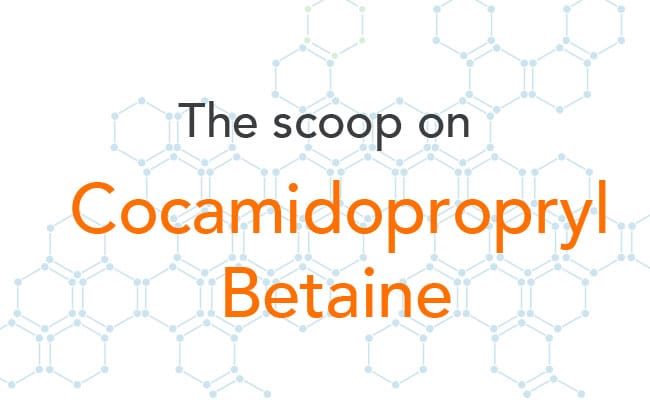
What is cocamidopropyl betaine?
Cocamidopropyl betaine is a synthetic detergent and surfactant that is used in personal care products, cosmetics [1][2] and cleaning products [3]. It is used to reduce static, condition the skin & hair, increase the foaming action of certain cleansing and cleaning products, and moderate the viscosity of liquids [1].
What products is cocamidopropyl betaine in?
As a synthetic surfactant, cocamidopropyl betaine is found in a number of personal hygience products like shampoo, toothpaste, contact lens solutions, skin care products like bath gels, cleaners, liquid soaps, and make-up remover, as well as personal hygiene products [1][2].
How to tell if a product has cocamidopropyl betaine
Look for a variety of different synonyms used to designate the presence of cocamidopropyl betaine. In cleaning products, look for these:
CADG, Cocamidopropyl betaine, Cocamidopropyl dimethyl glycine, Cocoamphocarboxypropionate, Cocoamphodiproprionate, Disodium cocoamphodipropionate
In personal care products, look for these:
1-propanaminium, 3-amino-n- (carboxymethyl) -n,n-dimethyl-, n-coco acyl derivs., inner salts; 1-propanaminium, n- (carboxymethyl) -n,n-dimethyl-3- [ (1-oxococonut) amino] -, hydroxide, inner salt; 1propanaminium, 3aminon (carboxymethyl) n,ndimethyl, ncoco acyl derivs., hydroxides, inner salts; cadg; cocamido betaine; cocamidopropyl dimethyl glycine; cocoamidopropyl betaine; cocoyl amide propylbetaine; cocoyl amide propyldi methyl glycine solution; cocoyl amide propyldimethyl glycine; hydroxide inner salt 1-propanaminium, n- (carboxymethyl) -n,n-dimethyl-3- [ (1-oxococonut) amino] –
Risks associated with cocamidopropyl betaine
Health concerns around cocamidopropyl betaine include allergic skin reaction and contact dermatitis when it comes into direct contact with skin and is not rinsed off [1] [2].
How to avoid cocamidopropyl betaine
To avoid cocamidopropyl betaine, read product labels and avoid products that contain this ingredient or any of the ingredients listed above as synonyms if the product will come into direct contact with skin. Follow the manufacturer’s application instructions which will likely recommend rinsing off skin.
In personal care products, do your own research on a product’s ingredients by using a resource such as the Environmental Working Group’s Skin Deep product database.
References:
[1] EWG’s Skin Deep Cosmetics Database (2007-2016). Cocamidopropyl betaine. Available online.
[2] Jacob, S.E. & Amini, S. (2008). Cocamidopropyl betaine. Available online: https://www.ncbi.nlm.nih.gov/pubmed/18627690 December 20, 2016.
[3] US Department of Health & Human Services Household Products Databases. Available online: https://householdproducts.nlm.nih.gov/cgi-bin/household/brands?tbl=chem&id=636&query=COCAMIDOPROPYL+BETAINE&searchas=TblChemicals January 23, 2107.



